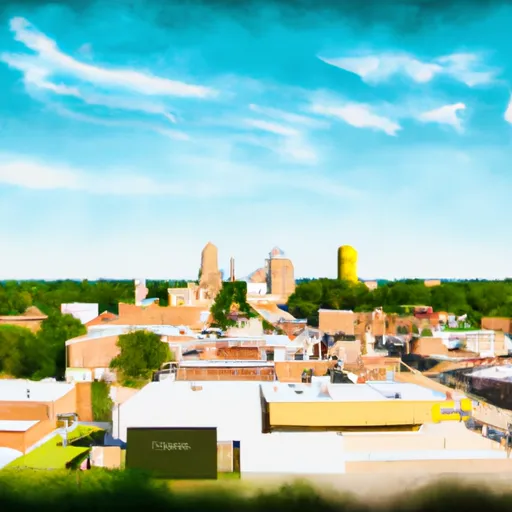-
 Snoflo Premium
Snoflo Premium
Get unlimited access to all our content
With no Ad interruptions! - Start Your Free Trial Login with existing account
Jerseyville
Eden Index
Climate
8.3
•
Recreation
3.1
•
Community
3.5
•
Safeguard
5.3/10

Jerseyville, Illinois is a charming town located in Jersey County. It experiences a humid subtropical climate, characterized by hot, humid summers and cold winters. Summers are typically warm, with average temperatures ranging from the mid-70s to the low 90s Fahrenheit, while winters can be cold, with temperatures dropping to the 20s and 30s Fahrenheit. Snowfall is common during winter months.
The town is enriched by the presence of the Mississippi River and its tributaries, offering various hydrology constituents. The Mississippi River is a prominent feature, providing opportunities for boating, fishing, and other water-related activities. Additionally, there are several smaller rivers and creeks in the area, such as the Macoupin Creek and Otter Creek, which offer scenic views and recreational options.
For outdoor enthusiasts, Jerseyville offers a range of recreational opportunities. Pere Marquette State Park, located nearby, encompasses over 8,000 acres of beautiful forests, hills, and bluffs. Visitors can enjoy hiking, camping, birdwatching, and picnicking in this scenic park. The town also has parks and trails, such as Lions Club Park and the Sam Vadalabene Bike Trail, providing opportunities for walking, biking, and other outdoor activities.
Overall, Jerseyville, Illinois offers a diverse climate, hydrology constituents, and outdoor recreational opportunities, making it an attractive destination for nature lovers and outdoor enthusiasts.
What is the Eden Index?
The Snoflo Eden Index serves as a comprehensive rating system for regions, evaluating their desirability through a holistic assessment of climate health, outdoor recreation opportunities, and natural disaster risk, acknowledging the profound impact of these factors on livability and well-being.
Climate Health Indicator (CHI): 8.3
Jerseyville receives approximately
991mm of rain per year,
with humidity levels near 81%
and air temperatures averaging around
12°C.
Jerseyville has a plant hardyness factor of
6, meaning
plants and agriculture in this region thrive during a short period during spring and early summer. Most
plants will die off during the colder winter months.
By considering the ideal temperature range, reliable water supplies, clean air, and stable seasonal rain or snowpacks, the Climate Health Indicator (CHI) underscores the significance of a healthy climate as the foundation for quality living.
A healthy climate is paramount for ensuring a high quality of life and livability in a region, fostering both physical well-being and environmental harmony. This can be characterized by ideal temperatures, reliable access to water supplies, clean air, and consistent seasonal rain or snowpacks.
Weather Forecast
Streamflow Conditions
Lower Illinois
Area Rivers
Lower Illinois
Snowpack Depths
Lower Illinois
Reservoir Storage Capacity
Lower Illinois
Groundwater Levels
Recreational Opportunity Index (ROI): 3.1
The Recreational Opportunity Index (ROI) recognizes the value of outdoor recreational options, such as parks, hiking trails, camping sites, and fishing spots, while acknowledging that climate plays a pivotal role in ensuring the comfort and consistency of these experiences.
Access to outdoor recreational opportunities, encompassing activities such as parks, hiking, camping, and fishing, is crucial for overall well-being, and the climate plays a pivotal role in enabling and enhancing these experiences, ensuring that individuals can engage in nature-based activities comfortably and consistently.
Camping Areas
| Campground | Campsites | Reservations | Toilets | Showers | Elevation |
|---|---|---|---|---|---|
| Lake Lincoln State Park | None | 426 ft | |||
| Greenville - Lake Wappapello | None | 382 ft | |||
| Percy Quin State Park | None | 416 ft | |||
| Bayou Segnette State Park | None | 0 ft | |||
| Lake Mary Crawford | 20 | 293 ft | |||
| Mississippi Petrified Forest | 15 | 294 ft | |||
| Lefleurs Bluff State Park | None | 288 ft | |||
| Fairview Riverside State Park | None | 4 ft | |||
| Sulphur Springs - Lake Wappapello | None | 391 ft | |||
| Bogue Chitto Water Park | None | 276 ft |
Nearby Fishing
Nearby Ski Areas
Catastrophe Safeguard Index (CSI):
The Catastrophe Safeguard Index (CSI) recognizes that natural disaster risk, encompassing floods, fires, hurricanes, and tornadoes, can drastically affect safety and the overall appeal of an area.
The level of natural disaster risk in a region significantly affects safety and the overall livability, with climate change amplifying these risks by potentially increasing the frequency and intensity of events like floods, fires, hurricanes, and tornadoes, thereby posing substantial challenges to community resilience and well-being.
Community Resilience Indicator (CRI): 3.5
The Community Resilience Indicator (CRI) recognizes that education, healthcare, and socioeconomics are crucial to the well-being of a region. The CRI acknowledges the profound impact of these elements on residents' overall quality of life. By evaluating educational resources, healthcare accessibility, and economic inclusivity, the index captures the essential aspects that contribute to a thriving community, fostering resident satisfaction, equity, and social cohesion.

